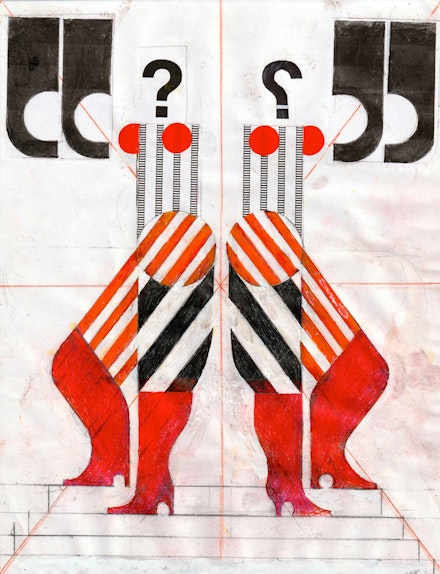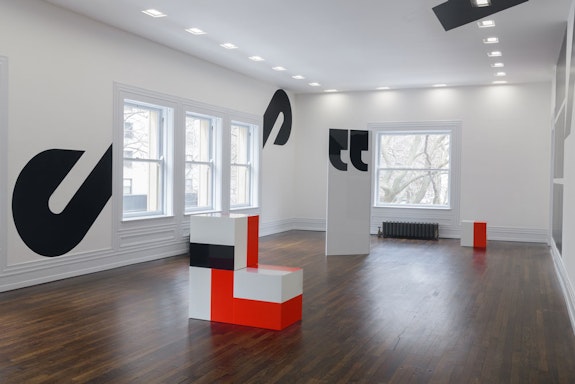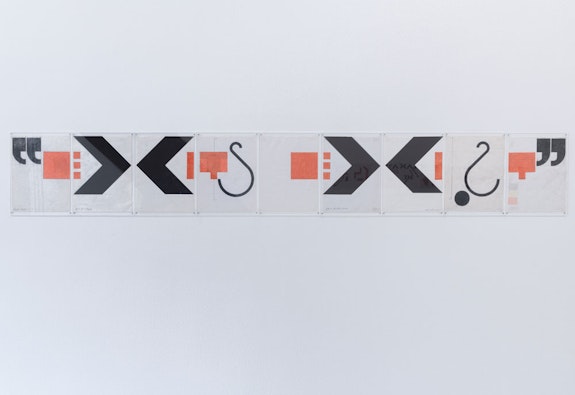ArtSeen
Barbara Stauffacher Solomon: Exits Exist

On View
Graham FoundationExits Exist
February 25–July 9, 2022
Chicago
While towering crimson and black graphics slice through walls and windowsills downstairs, corresponding flat shapes assume the form of dimensional objects in the upstairs galleries—thus assembling the experience of Barbara Stauffacher Solomon’s exhibition, EXITS EXIST, into that of a large-scale pop-up book. And indeed, the book form plays a central role in the structuring of the work: the spines of mirrored black chevrons meet in corners of rooms and modular cube objects serve as both pedestals and seats in support of the artist’s books, displayed on the second floor. This literary analogy reveals most, however, where it is complicated by a socio-historical plot. In fusing architecture and typography through her signature supergraphics, Solomon incises the elegant 1902 Prairie-style mansion housing the Graham Foundation galleries with the sharp precision of Modernist graphic design and the stinging irreverence of a carefully crafted and dexterous wit.

Extending from work presented at LAXART (Los Angeles) in 2019, Solomon’s crisp black hooks and red stripes span the white walls of the first floor galleries from floor to ceiling, not slowing for mahogany trim nor stone fireplace. The planes of color cut through doorways undaunted, with shapes matching and recombining across rooms, compressing space in direct response to the position of the viewer. This simultaneous dissection and correspondence furthers the sensation of being among leaves of a text, to the point where the window panes themselves appear suspicious, belying the depth of the city streets on the other side.
Upstairs, under the auspices of chevron supergraphics now stretching onto the ceiling of the East Gallery, stark black quotation marks on hinged wood panels reveal the first insight into the nature of the graphic forms. Flanked by an arrangement of red, white, and black cubes, the hinged sculptures bear a set of recognizable shapes which offer a segue, directing one’s attention to the intimate scale and wordplay of both the surrounding artist’s books and mixed media works on paper. Once recalibrated, it becomes apparent that the nine small drawings in the adjacent Central Gallery show familiar forms: quotation marks, mirrored chevrons, black hooks, red blocks and stripes. Read from left to right, the shapes spell the phrase “EXITS EXIST”: the immense graphics perforating the lower galleries are not merely abstract forms, but words to be read.

If the pop-up book and supergraphics describe the formal quality of the exhibition, the upstairs also holds the key to socio-historical context comprising what could be considered the content or plot of the work. On several cube pedestal-seats rest copies of Solomon’s experimental autobiography, Why? Why Not?, which begins with an account of her time spent studying with eminent graphic designer Armin Hofmann in 1950s Switzerland. Considered a pioneer of the iconic modernist “International Typographic Style,” Hofmann emphasized communicability and clarity, dedicating himself to the socialist political ideal of a universal, democratic graphic language, sans excess or ornamentation. Armed with grids and precise forms, Solomon returned to her native California where, despite encountering resistance to the strict rationality of Swiss design, she was presented with a similarly utopian project. The Sea Ranch would be a commune-style settlement, an experiment with the then-uncommon condominium structure. Working on the Sea Ranch project, she found the freedom to develop her own large-scale typographic language.

Poignantly, however, in EXITS EXIST, the supergraphics slice not into the optimistic dream of an ideal future, but through the historical artifact: the public institution which was once a home. A turn-of-the-century mansion once belonging to Chicago’s Madlener family, what now serve as galleries once housed a living room, music room, dressing room and bedroom—private spaces for dwelling and entertaining. As traces of this intimacy remain etched into the rooms, Solomon’s expert incisions collapse and expand spatially—but also through layers of history and temporality. In the sense that the chevrons and stripes coincide with mid-century utopian ideals and a space transformed from the domestic into a public institution, the exhibition reads not so much as a pop-up book, but as a pop-through. Perhaps more aptly, exits (co-)exist.
Postmodern in the literal sense, Solomon’s work models a plurality characteristic of the contemporary. The sensation of a flattened space in the galleries requires the perception of the viewer to complete the work—another break from the strictures of modernism. Yet unlike much contemporary work, Solomon’s oeuvre is absent of the cynicism which often parallels this acknowledgment of the failures of mid-century idealism. EXITS EXIST embodies an older, wiser use of modernist vocabulary, forming a continuation of these explorations, rather than an allegorical appropriation. Her steadfastness, as evidenced by this exhibition, instead bears witness to nearly a century of changes, recorded with a steady hand and penetrating intellect. Through all of this, Solomon’s work retains a profound playfulness and optimism: exits, escapes, dreams do exist—an affirmation.

